Puffbird facts for kids
Quick facts for kids Puffbirds and allies |
|
|---|---|
 |
|
| Scientific classification |
|
| Kingdom: | Animalia |
| Phylum: | Chordata |
| Class: | Aves |
| Order: | Piciformes |
| Suborder: | Galbuli |
| Family: | Bucconidae Horsfield, 1821 |
| Genera | |
|
|
Puffbirds are cool tropical birds that live in trees. They eat insects and are found from South America all the way up to Mexico. These birds are related to jacamars, and together they belong to a larger group called Piciformes. This group also includes woodpeckers and toucans!
Puffbirds don't have super bright, shiny colors like jacamars. Instead, they are usually brown, reddish-brown, or grey. They have big heads, large eyes, and flat bills with a hooked tip. Their feathers are very loose and fluffy, and they have short tails. This makes them look round and "puffy," which is how they got their name! Puffbirds come in different sizes. The smallest is the rufous-capped nunlet, which is about 13 centimeters (5 inches) long and weighs about 14 grams (half an ounce). The biggest is the white-necked puffbird, which can be up to 29 centimeters (11 inches) long and weigh about 106 grams (3.7 ounces).
Contents
What are Puffbirds?
Puffbirds got their name because of their fluffy feathers. In Spanish, people sometimes call them bobo, which means "dummy." This is because they often sit very still for a long time, waiting for their prey.
An American scientist named Thomas Horsfield first described the puffbird family in 1821. Scientists have studied their bones and muscles to figure out how they are related to other birds. They also look at DNA to understand their family tree. Studies show that puffbirds and jacamars are very close relatives. They are like sister groups within the Piciformes order. This means they share a common ancestor with woodpeckers and toucans.
Puffbirds have special feet called zygodactyl feet. This means they have two toes pointing forward and two toes pointing backward. This helps them grip branches very well!
Where Do Puffbirds Live?
Puffbirds live in many places, from Mexico down to southern Brazil. You can find the most different kinds of puffbirds in the Amazon Basin. They like to live in forests and wooded areas. This includes lowland forests, forests in the foothills of mountains, and open woodlands.
Most puffbirds live in lower areas. However, the white-faced nunbird is one of the few that lives in higher mountain areas. The swallow-winged puffbird also likes more open spaces, not just dense forests. Puffbirds usually stay in their home territory and don't travel very far.
What Do Puffbirds Look Like?
Puffbirds usually have dull-colored feathers. But some of them have bright bills, eyebrows, or eyes! They have large heads, short wings, and strong bills. Their legs are short, and their feet are small.
Male and female puffbirds look a little different. The female is usually a bit bigger and her feathers are slightly less bright than the male's. Young puffbirds have shorter beaks than adult birds.
Puffbird Sounds
Puffbirds are known for being very quiet birds. They don't make sounds very often. The birds called nunbirds and those in the Nystalus group are the most vocal. When they do call, it's usually at dawn or dusk. Their main calls are repeated, high-pitched whistles. Nunbirds have many different calls and can make very loud shouts!
Puffbird Behavior
Puffbirds spend most of their time in trees. They are often secretive and can be found alone or in small family groups. However, the birds in the Monasa group, known as nunbirds, are more social. They often live in flocks.
What Do Puffbirds Eat?
Puffbirds are "sit-and-wait" hunters. This means they perch very still for a long time, watching for insects to fly by. Besides insects and other arthropods (like spiders), they might also eat small lizards and some plant material. After they eat, they sometimes spit out pellets of undigested insect parts. The swallow-winged puffbird is special because it's the only one in its family known to catch insects while flying from an open perch.
Puffbird Life Cycle
Scientists don't know a lot about how puffbirds raise their young. They build their nests in burrows. These burrows can be in dirt, rotten wood, or even termite mounds. Female puffbirds usually lay two or three eggs. The eggs are small, round, and white.
Both parents help to incubate the eggs, which means they sit on them to keep them warm. This takes about 15 days. When baby puffbirds hatch, they are blind and have no feathers. But after only one or two days, they can crawl to the entrance of their nest burrow! Their mother feeds them insects that she has partly chewed. The young birds are ready to leave the nest when they are about 20 to 21 days old.
Puffbird Species
Here are some of the different types of puffbirds:
| Image | Genus | Living Species |
|---|---|---|
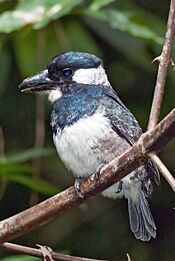 |
Notharchus |
|
 |
Bucco |
|
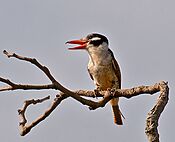 |
Nystalus |
|
 |
Hypnelus |
|
 |
Malacoptila |
|
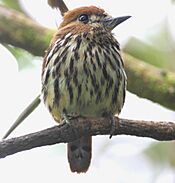 |
Micromonacha |
|
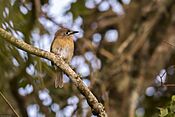 |
Nonnula– the nunlets |
|
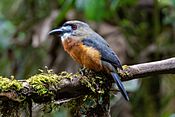 |
Hapaloptila |
|
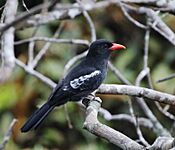 |
Monasa– the nunbirds |
|
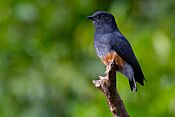 |
Chelidoptera |
|

